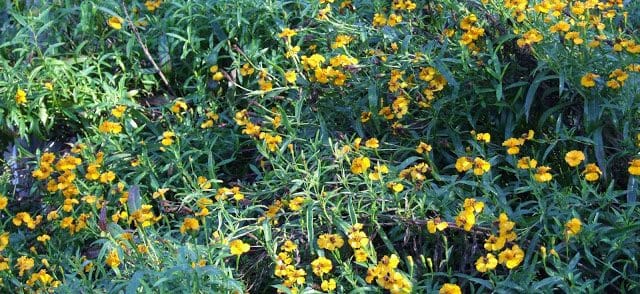Tarragon grows easily in my garden (I have the Mexican variety) and I let it fill some of those areas that can get a bit dry and neglected. I had no idea how useful it was until recently. I appreciated it’s abundance, it’s hardiness, it’s flowers, it’s scent and interesting flavour addition to salads, but there’s so much more!
 |
| Tarragon is a hardy perennial herb with a liquorice flavour and abundant flowers. This is Mexican Tarragon. |
Tarragon: the plant
Tarragon is a perennial hardy herb (of the sunflower family) which renews itself every year with fresh new growth. The abundance of soft leaves smell like liquorice when rubbed. Some people love it, others are repelled – a bit like the cabbage moths and other pests (a good reason to plant it in many places around your garden!)
There are three tarragons – French, Russian and Mexican Tarragon. Of the three, French tarragon (Artemisia dracunculus) has the more refined aroma and flavour and is better therefore for culinary use. The french variety is usually flowerless – this is a good way to tell the difference. Russian Tarragon (Artemisia dracunoculoides) has far less flavour and the flavour diminishes with age too. Mexican Tarragon (Tagetes lucida) is a good substitute for the French Tarragon in cooking.
Another name for Tarragon is dragon wort – Maia, Hugh and Monty prefer that name! It is of the Asteraceae family and written records of tarragon being cultivated date back to 500 B.C.
In a cold winter, the tops of tarragon will die right back. Cut off these dead top growth and cover well with mulch. New growth with burst through when the warmth returns. Tarragon is thought to be a nurse plant – enhancing the growth and flavour of crops grown with it – eggplant especially.
 |
| French Tarragon |
Tarragon in the kitchen
A couple of leaves added into a salad or sauce add a fresh twist. You don’t need much as the flavour is so strong. Although I have seen tarragon referred to in French and Mediterranean cuisine, I was unaware that it is actually one of the four finest seasonings in traditional French cooking. I will endeavour to be a little more creative in the kitchen with this lovely herb.
It’s good to note that it’s never a good idea to use tarragon in soups or dishes needing long boiling time as it can become bitter.
Tarragon Herb Vinegar
A lovely herb vinegar can be made by steeping a large handful of the soft tops in wine vinegar for a week. After one week, remove the herbs and store in a glass bottle. Culinary herb vinegars are used in salads, cooking and marinades.
Tarragon for teeth
I was drawn to deepen my knowledge Tarragon because in my exploration of herbs for teeth and gum health yesterday, I found that it can be used to reduce tooth pain. I hadn’t realised that it a similar effect to cloves – numbing the area. Apparently ancient Greeks knew this and used to chew on a few leaves to ease the pain of toothache. Actually the essential oil, eugenol (the same as in clove oil), is in therapeutic use in dentistry as a local anaesthetic and antiseptic of toothache complaints.
Tarragon for eyes
Tarragon for digestion
Tarragon tea for good sleep
Tarragon for headaches
Throwing a handful of leaves into a pot of boiling water and inhaling the fumes will help to soothe a headache, and also clean the nose and chest. Tarragon vapour can also ward of mosquitoes flies and roaches.
Tarragon – the antioxidant
Another surprising piece of information I found is that fresh tarragon is one of the highest antioxidant value food sources among common herbs. It is a very rich source of vitamins such as C, A, as well as the B-complex group. Being rich in phytonutrients and antioxidants, Tarragon helps to promote heath and prevent diseases. Studies have found that tarragon oil works as a free radical scavenger.
Fresh herbs are always preferable to dried herbs for the nutrient and medicinal value. If you can grow or access fresh herbs, always choose this. Tarragon will grow well in a pot if you have little garden space.
Tarragon minerals
Tarragon is also an excellent source of minerals such as calcium, manganese, iron, magnesium, copper, potassium and zinc.
 |
| Russian Tarragon |
Other Tarragon Uses
How do you use Tarragon – in the garden, kitchen or medicinally?


